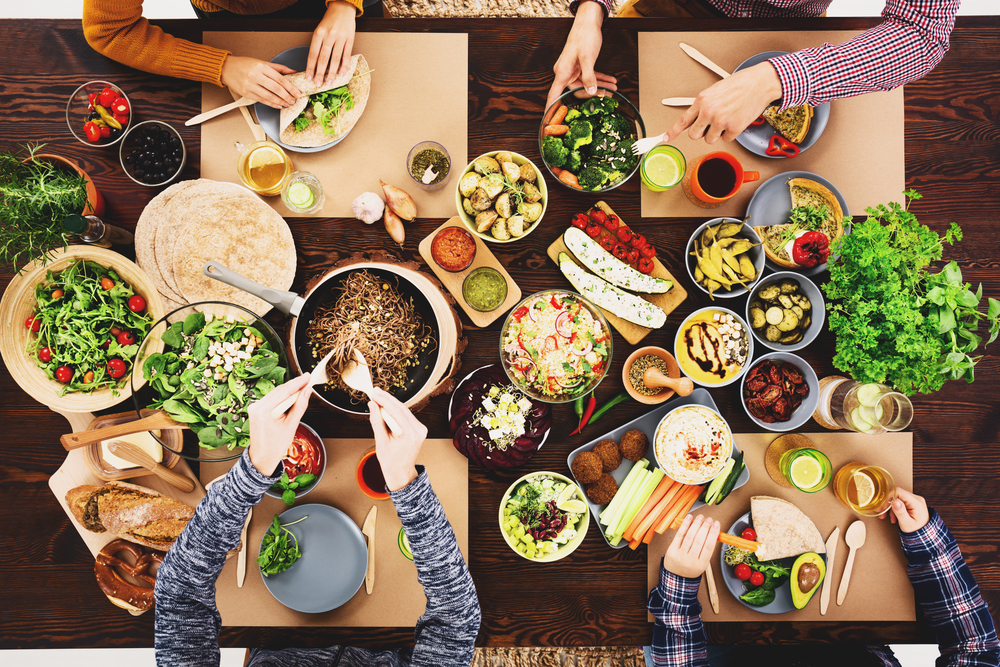
Adding plant-based food to your diet
Looking for healthy recipes?
Research clearly shows the benefits of adding plant-based items to our diet. But what are the plant-based food options and what makes them so good for our health?
Plant-based proteins
There are more than vegetables, fruit and grains in a plant-based diet. Foods such as soy, legumes and nuts are high in protein and can be eaten in their original form. They also can be used to make meat alternatives like black bean burgers or soy “ground beef.”
- Soy options include edamame (whole, immature soybeans), soy milk, tofu (also known as bean curd) and tempeh (a block of soybeans that have been pressed together and fermented).
- Legumes are a plant family and include beans (black, green, lima, navy, kidney, etc.), lentils, chickpeas (also called garbanzo beans) and peas.
- Nuts and seeds are a staple food group for a healthy plant-based diet. Examples include raw almonds, walnuts, chia seeds, flaxseeds and hemp seeds.
Benefits of a plant-based diet
You may have many reasons why you might want to stop consuming meat. Some benefits of a plant-based diet to consider:
- Conserves natural resources like water
- Helps to lower cholesterol, may protect against cancer, prevents heart disease and helps in managing diabetes
- Can save money – meat usually costs more per pound than other protein sources
Nutritional differences of plant-based foods
Plants have key nutrients like antioxidants and fiber that are missing from meat. Vitamin C and other antioxidants are helpful for disease prevention and fiber is important for gut health. However, some plants can be low in some B vitamins or iron, which are normally high in meats.
The American Heart Association recommends having no more than 6% of your total calories from saturated fat. The dietary guidelines for Americans recommends having 10-35% of your calories from protein per day. So if you ate 2,000 calories, that would equal 13 grams of saturated fat and an average of 113 grams of protein for the day. Take a look at different protein options to see how they compare in protein and saturated fat:
- Ground beef (90% lean, 4 ounces raw) – 23 grams protein, 4 grams saturated fat
- Chickpeas (canned, 1 cup) – 11.8 grams protein, .28 grams saturated fat
- Tofu (firm, 3 ounces) – 9 grams protein, 1 gram saturated fat
- Almonds (slivered, ¼ cup) – 6 grams protein, 1 gram saturated fat
- Black beans (canned, ½ cup) – 7 grams protein, 0 grams saturated fat
But how do they taste?
Things like the meat alternatives and tofu are lower in fat and are less moist than some meats. The best thing to do is make sure to not overcook them. They’re just plants after all, so you don’t face the danger of getting sick in the same way you would if you ate raw or undercooked meat.
In terms of flavor, the alternative itself is a blank slate so they are a great sponge for spices. Grab your favorite spices to add in flavor that best suits your recipe. Things like chili powder, paprika, herbs and garlic add a great punch of flavor to the alternative and help add variety.
How to use plant-based proteins in meals
Many legumes, like chickpeas, come canned and are easy to add to a variety of dishes. A nice rule of thumb to go by is if you could use ground beef, ground chicken or ground turkey in a recipe, you can probably sub it with a plant-based protein.
Use beans for burritos instead of ground beef, add extra beans in a chili instead of ground meat or have a bean burger patty instead of a beef patty.
Replacing meat with legumes in those recipes or using meat alternatives or tofu drops the saturated fat and raises the fiber in a meal, which makes it better for you.
What if I don’t want to give up meat?
Then you shouldn’t. Meat is a great source of so many vitamins and minerals that can be hard to get from plants, so going completely vegetarian or vegan may not work for a lot of people.
Meat is also a part of a lot of family traditions and cultures, and taking that out of a diet completely can make people feel left out of family gatherings.
The takeaway
It’s all about adding in some plant-based proteins where you see fit and trying to make a few swaps that feel good for you. There are many types of recipes you can find online, so take the opportunity to experiment to find something you like.